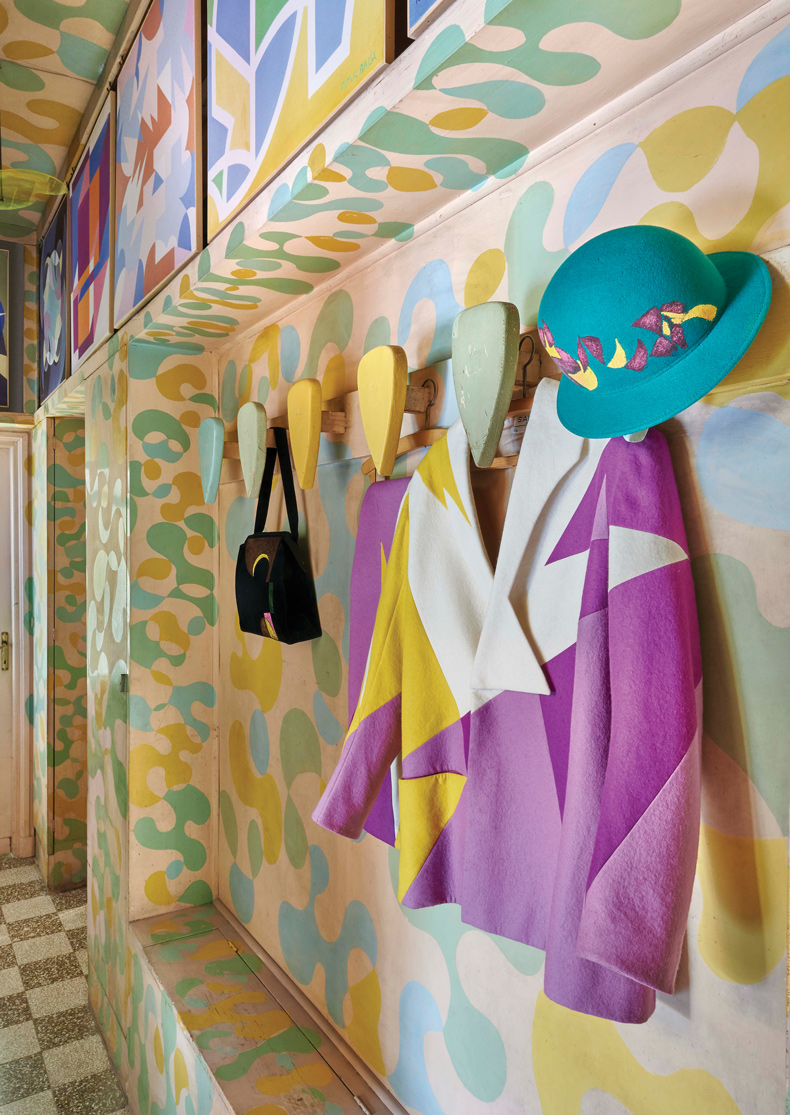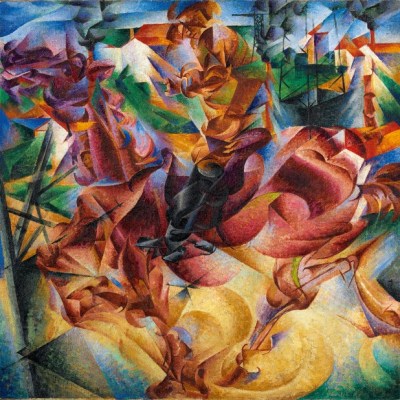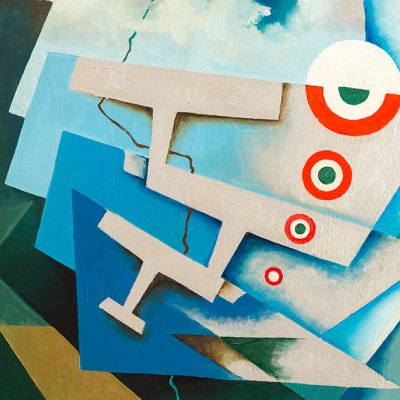From the July/August 2023 issue of Apollo. Preview and subscribe here.
Boy, did the Italian Futurists like their manifestos. It all started in 1909, with the publication in Le Figaro of F.T. Marinetti’s founding manifesto, which advocated, among other things, speed, movement and aggression, and declared a roaring automobile more beautiful than the Winged Victory of Samothrace. Afterwards came the ‘Manifesto of the Futurist Painters’, the ‘Technical Manifesto of Futurist Literature’, ‘The Art of Noises’, ‘Futurist Dance’, ‘Manifesto of Futurist Cooking’… Not much here suggests you’d have many laughs at a Futurist dinner party (whoopee cushions don’t feature in ‘The Art of Noises’). But in the ‘Futurist Reconstruction of the Universe’, published in 1915 by Giacomo Balla and Fortunato Depero (of Campari soda bottle design), there is at least a hint of something more light-hearted: for those two artists, remaking the universe involved ‘cheering it up’.
In an apartment on the fourth floor of an unremarkable block in north-west Rome, that spirit is fully felt. The writer Emanuele Trevi has called Casa Balla one of those marvels ‘hidden among the most prosaic of existences, between the smell of cauliflower that periodically invades the stairwell and the sacred silences of the afternoon nap’. To step over the threshold into the home Giacomo Balla shared with his wife, Elisa, and their two daughters between 1929 and his death in 1958 is to step into a cheerful universe indeed; cheerful, energising, dizzying. (The fact that the paying public has, since 2021, been able to step over the threshold at all is down to the MAXXI, which manages the apartment.) Here is the Futurist idea of the opera d’arte totale made reality: multi-coloured painted elements dance across ceilings, walls, door surrounds; anthropomorphic furniture sits on floor tiles glazed with vibrant motifs; abstract designs on rugs, embroidered tablecloths, ceramic vessels, canvases. No single medium has superior status. Colour and pattern reign supreme.
One of Giacomo Balla’s ‘anti-neutral’ suits hangs with hat in the corridor on a coat rack also of his design. Photo: M3Studio by SIAE 2023; courtesy MAXXI; © Giacomo Balla/DACS 2023

The corridor, that unloved workhorse of the urban apartment, has here become the main decorative event. Using a palette of pastel green, yellow and blue, Balla enlivened its walls and ceiling with amoeba-like painted forms, their shapes ingeniously repeated in translucent ceiling lights made out of coloured acrylic. Round the corner, the palette shifts to moodier, jewel-like colours, and you can almost hear the long-faded music of the Futurist cabaret club Bal Tik Tak, which Balla was commissioned to decorate in 1921 (and which influenced Theo van Doesburg’s decoration of the Café l’Aubette in Strasbourg later that decade). As the syncopated shapes move along the wall into a compact study at the end, there are echoes, too, of the elaborately decorated studioli of great men of the Renaissance. Balla said of himself: ‘In the 1500s my name was Leonardo or […] Titian. After four centuries of artistic decadence, I have reappeared in the 20th century to create a new sensibility.’
Between 1904 and 1926 the Ballas had lived in a former monastery on the edge of the Villa Borghese gardens. It was while living in this rustic, archaic setting that Giacomo Balla espoused and developed that new sensibility – one concerned with modernity, technology, movement and light. It was here that he painted notable works such as Street Light (1909), which still employed the divisionist technique that Balla had borrowed from the Neo-Impressionists after a spell in Paris: bold brushstrokes of distinct, unmixed colours. Yet both its subject matter – the electric streetlights being installed in Rome at the time – and the sense of energy and dazzle in the V-flecks of paint radiating from the centre lend it a Futurist flavour. In 1912 came Dynamism of a Dog on a Leash, Balla’s brilliant attempt, inspired by the photographic experiments of Eadweard Muybridge and Étienne-Jules Marey, to render in paint the effect of figures in motion. (And it’s hard not to be cheered by the sight of that dachshund’s little legs whirring beside the long skirt of its mistress.) Meanwhile, putting into practice the Futurist conceit that there should be no separation between art and life, Balla transformed his family’s once-monastic surroundings into a ‘total environment’, getting his hands ‘smeared with glue, saw wood, cut up sheets of paper and cardboard to make lamps, lampshades, screens and toys’; dubbed the ‘House of the Magician’ by his followers, it could be visited by members of the public every Sunday afternoon.
The corridor ends in the Studiola Rossa, where one of Balla’s Futurist sculptures hangs from the ceiling. Photo: M3Studio by SIAE 2023; courtesy MAXXI; © Giacomo Balla/DACS 2023

When the family was forced to move to the comparatively bland surroundings of Via Oslavia in the bourgeois Delle Vittorie district, it was without much initial enthusiasm. Yet here they truly had a blank canvas. More significantly, the artist’s daughters would now contribute fully to this second Balla universe. Born in 1904 and 1914 respectively, Lucia and Elica Balla had Futurism baked into their very names: the former was soon known as Luce (‘light’), while Elica is the Italian word for ‘propeller’. Elisa Balla was a skilled seamstress, and from the first had been translating her husband’s designs onto tablecloths and other textiles – including his extraordinary ‘anti-neutral’ suits with their jagged lightning bolts of colour. By the time of the move to Via Oslavia, both daughters had inherited their mother’s aptitude with a needle and their father’s with a paintbrush. In the kitchen – where one hopes the family wasn’t subjected to recipes from Marinetti’s Futurist Cookbook – a touchingly domestic group portrait by Elica has her father, mother and sister seated around the kitchen table, Giacomo observing his wife while she reads a newspaper (or is that another manifesto?), and Luce working with needle and thread. Cupboard doors here and window shutters elsewhere have been painted with flowers, birds and trailing vines, lending a lyricism – even a folkiness – to these interiors that somehow sits happily with the Futurist shards of colour flashing across plates, canvases and painted ceilings.
Here, then, is a machine-worshipping movement being served by the skill and labour of the human hand. That much of it was made by female hands, too, flies in the face of Marinetti’s misogynist founding principles, which promoted ‘contempt for woman’. Luce and Elica both exhibited work in Futurist shows, but soon abandoned the style (by the late 1930s Giacomo Balla too had reverted to the figuration of his early career, now convinced that ‘pure art is to be found in absolute realism’). A whole wall of Elica’s bedroom is hung with a series of luminous cloud canvases; it’s tempting to think of these as her revisiting of the Aeropaintings both she and her father made in Futurist mode – this time with the roaring flying machines removed to leave only calm skies. The sisters lived on here long after their parents’ deaths, dying within a year of each other in the 1990s. Casa Balla’s cheer owes as much to them as it does to Futurism.
Casa Balla in Rome is open until 15 July. More details and future opening dates are available from MAXXI, Rome.
From the July/August 2023 issue of Apollo. Preview and subscribe here.


